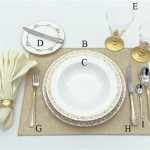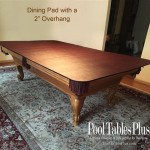How Many Chairs Can Sit Around a 60-Inch Round Table?
Determining appropriate seating arrangements for events or dining spaces involving round tables is a common consideration. Understanding the relationship between table size and comfortable seating capacity is essential for planning purposes. A 60-inch round table is a popular choice, and accurately estimating the number of chairs that can comfortably fit around it requires careful consideration of several factors.
The diameter of the table, in this case, 60 inches, serves as the primary determinant. However, simply dividing the circumference by a standard chair width will not provide an accurate answer. This is because the actual usable space around the table is influenced by factors such as chair size and the desired personal space between seated individuals. Moreover, the table's base can influence chair placement, especially if it is significantly wide. The style and intended use of the seating arrangement also play a crucial role.
This article will explore the various considerations involved in determining how many chairs can comfortably fit around a 60-inch round table. It will delve into the standard space allowances, chair dimensions, and common seating arrangements to provide a practical guide for event planners, interior designers, and individuals seeking to optimize their dining or meeting spaces.
Understanding Standard Seating Space Allowances
The concept of 'personal space' is fundamental to comfortable seating. People require a certain amount of space to move freely, converse, and access the table without bumping into their neighbors. Industry standards and ergonomic recommendations provide guidelines for these space allowances. Generally, catering to a comfortable dining experience dictates allocating around 24 to 30 inches of linear space per person around the table's circumference.
The smaller end of this range, 24 inches, is more suitable for casual dining or situations where a more compact arrangement is required, such as a cafe or bistro setting. A 24-inch allowance allows for closer proximity between guests, potentially creating a more intimate atmosphere. It is not suitable for formal or extended dining as it can feel cramped over longer periods.
The larger end of the range, 30 inches, provides a more generous and comfortable space per diner. This allocation is appropriate for formal dining settings, business meetings, or situations where guests require more personal space. This spacing allows for easier movement and encourages more relaxed conversation. Using this allowance is important for events where guests may be wearing formal attire or when physical comfort is a paramount concern.
Calculating the circumference of a 60-inch round table is essential to determine the available linear space. The formula for circumference is C = πd, where 'C' is the circumference, 'π' (pi) is approximately 3.14159, and 'd' is the diameter. Applying this formula, the circumference of a 60-inch round table is approximately 188.5 inches.
Dividing the circumference by the space allowance per person yields the approximate number of chairs that can fit. Using the 24-inch allowance, 188.5 inches / 24 inches/person ≈ 7.85 people. Using the 30-inch allowance, 188.5 inches / 30 inches/person ≈ 6.28 people. These calculations suggest that a 60-inch round table can comfortably seat approximately 6 to 8 people, depending on the desired level of spacing.
Impact of Chair Dimensions and Style
While space allowance is an important consideration, the actual dimensions of the chairs themselves play a crucial role in determining the seating capacity. Chairs vary significantly in width, depending on their style and design. A bulky armchair will take up considerably more space than a slender dining chair. Therefore, it's necessary to consider the actual footprint of the chair, not just the theoretical linear space available.
Standard dining chairs typically range in width from 18 to 22 inches. Chairs with arms generally require more space compared to armless chairs. When using chairs with arms, it's crucial to ensure that the arms do not impede movement or cause discomfort to neighboring diners. Larger chairs with wider dimensions may require a greater space allowance per person to account for their broader footprint at the table.
Beyond width, the depth of the chair, including the backrest, also impacts the overall space requirement. Chairs with high, deeply reclined backrests may require more clearance from the table edge. This is particularly important if guests will be moving in and out of their seats frequently. The height of the chair in relation to the table is also essential for comfortable dining. A chair that is too low or too high can cause discomfort and affect the overall dining experience.
The style of the chair can also influence the optimal seating arrangement. For instance, Chiavari chairs, commonly used in formal events, tend to be narrower than upholstered dining chairs. This can allow for a slightly tighter seating arrangement around the table without compromising comfort excessively. Conversely, chairs with wider bases or ornate detailing may reduce the number of chairs that can comfortably fit.
Moreover, the chair base impacts the surrounding space. A pedestal base will require less space than four legged chairs. Chair materials can also influence space, as some chairs might be heavier and harder to move, requiring more space to comfortably get in and out. Therefore, practical testing involving placing actual chairs around the table is highly recommended to validate the space requirements before a large event.
Practical Considerations and Table Usage
In addition to space allowances and chair dimensions, several other practical considerations can influence the decision regarding the number of chairs around a 60-inch round table. The intended use of the table is a primary factor. A table used solely for dining requires different considerations than a table used for meetings or displays.
For instance, when a table is used for dining with multiple courses, it requires sufficient space for tableware, glassware, and serving dishes. If space is limited, passing dishes and using utensils can become cumbersome. The type of food served also influences the space requirement. A buffet-style meal requires less individual space than a formal plated dinner.
If the table is intended for board games or interactive activities, additional space may be needed for game components, score sheets, and personal items. Similarly, if the table is used for work-related activities, such as meetings or presentations, adequate space is needed for laptops, notebooks, and other work materials. In such situations, it might be necessary to reduce the number of chairs to provide sufficient workspace for each participant.
The accessibility of the table is another important consideration. Ensuring easy access for individuals with mobility challenges is essential. Wider pathways around the table and sufficient space between chairs can accommodate wheelchairs or other mobility aids. Compliance with accessibility regulations, such as the Americans with Disabilities Act (ADA), may also dictate specific seating requirements.
The ambiance and décor of the room also contribute to the overall seating arrangement. A crowded table in a small room can feel claustrophobic, while a sparsely populated table in a large room can feel isolated. Striking a balance between functionality and aesthetics is crucial for creating a comfortable and inviting environment. Thoughtfully selected linens, centerpieces, and lighting can enhance the dining experience and improve the overall perception of space.
In summary, while calculations based on standard space allowances and chair dimensions provide a useful starting point, the ultimate decision regarding the number of chairs around a 60-inch round table should be informed by a careful consideration of these practical factors. These factors will not only facilitate a more comfortable experience but also improve the utility of the table itself.

72 Round Plywood Banquet Table The Chiavari Chair Company

60 Round Table Seat 8 To 10 Destination Events

How Many People Fit At A 5ft Round Table 306 Party Als Tents Tables Chairs Decor

60 In Round Table Mtb Event Als

60 Round Table Seat 8 To 10 Destination Events

The Right Number Of Chairs For Any Table Canadel S Blog

How Many Chairs Fit At A Table

60 In Round Table Mtb Event Als

Table Seating Capacity Contemporary Craftsman Furniture

Table Als Big Tent Events








